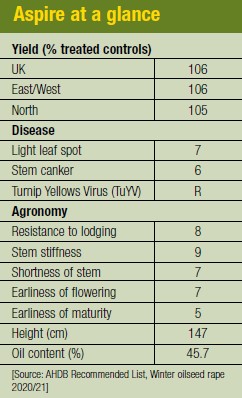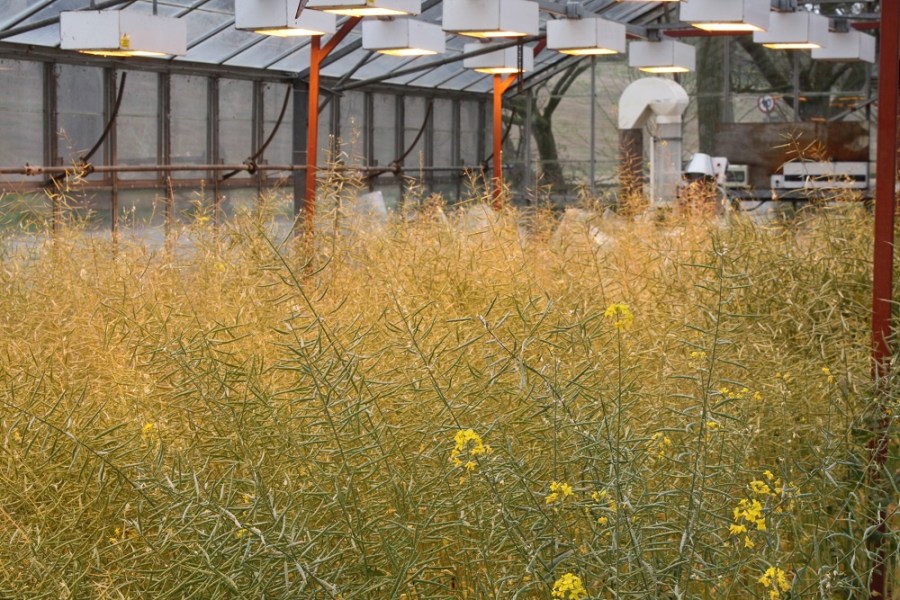For oilseed rape growers looking to protect themselves with TuYV resistance, there’s arguably only one open-pollinated variety that’s up to the job. CPM reviews Aspire.
Year-on-year it’s proved to be a very robust variety.
By Charlotte Cunningham
Since the loss of the neonicotinoids in 2016, control of aphids has become more and more difficult, leaving growers looking to variety choice as a form of protection against the yield-robbing virus.
However, the options in conventional OSR have been limited. Until now…
Following its recommendation on the AHDB Recommended List in 2019, Limagrain’s latest offering has proved to be anything but conventional. Meet Aspire, the only open-pollinated winter oilseed rape on the RL with TuYV resistance.
While Limagrain was the first to introduce commercialised TuYV resistance within their 2014 variety, Amalie, Aspire marks a new generation of performance, explains William Charlton, Limagrain’s UK arable marketing manager. “TuYV is now a standard trait so the actual breeding process is fairly straightforward. Now, when we have the crosses that carry the particular trait, we fix the gene in the breeding cycle from stage one.”
Since its initial introduction, the whole industry has moved into breeding with TuYV in mind, but this has sometimes been at the detriment of yield, he adds. “Amalie, for example only had a yield potential of about 98% of controls.
“However, over the past few years, there’s been huge genetic improvement meaning we’ve moved from the bottom of the pile to the top by quite a margin – with Aspire sitting at a UK yield average of 106% of controls.
“The TuYV research process started in 1992, so it’s taken us two decades to perfect, but I think we’re there now.”
Aspire has been very successful in both official and on-farm trials, and when it was recommended, it was the highest yielding OSR variety on the RL, adds Will. “Year-on-year it’s proved to be a very robust variety across the board which has attracted growers and Aspire often sells itself through its performance in on-farm trials.”
Last year’s harvest results from trials conducted by the AICC in West Wittering, Sussex, showed that there was at least a 0.4-0.5t/ha yield advantage from varieties with TuYV resistance against those without.
“Aspire particularly stood out in this trial, yielding 6.7t/ha – that’s a massive bonus over the 6.1t/ha from Django or 6t/ha from Campus,” explains Peter Cowlrick, AICC. “In a second trial in West Sussex, the trend was the same, with TuYV-resistant varieties leading the pack.”
While growers often seek out hybrid types for their high yield potential, Aspire balances performance with some of the easier management aspects that conventional varieties glean, adds Will. “Hybrids are normally the focus for breeders and growers, but we wanted to provide this level of performance for growers who prefer to grow conventional OSR.
“Aspire is short and stiff-stemmed, steady to grow and therefore easier to manage which we know is one of the key reasons growers opt for conventional varieties. TuYV resistance is the icing on the cake.”
While recommended for all regions, Aspire has performed particularly well in the more testing environment of the North, adds Will. “Aspire has shown a very high untreated northern gross output and seed yield reflecting the varieties strong agronomic package for on farm performance.”
So the potential is there on paper, but how has Aspire fared in a competitive market? “It was our largest selling conventional variety last year, limited only by availability,” says Rodger Shirreff, national seed business manager at Agrii. “This was driven mainly by Aspire’s high gross output, and of course, it’s TuYV resistance which is becoming increasingly important for growers.”
Agrii have positioned the variety as suited to early drilling, and with some growers abandoning hopes of 2020 crops – and instead turning to focus on harvest 2021 – Aspire could be an ideal choice for OSR growers this year, he adds. “There are definitely quite a few farmers preparing to give their soils a break this summer, so there’s an extended period to get land clean and ready for that early window.”
AICC agronomist, John Cook has been working with the variety since its launch and says that although TuYV is often the initial attraction, Aspire also has very good in-the-field performance. “Aspire has good vigour, establishes well and has good standing power,” he says. “There’s no real weaknesses and coupled with excellent yield and TuYV resistance, it’s a great all-round variety.”
John notes the TuYV resistance as a particular strength of the variety due to its role in helping both growers and agronomists be more flexible with their approach to fungicide programmes. “TuYV resistance embedded within a variety helps build resilience, particularly in autumns where aphid control isn’t possible due to compromised spray windows.”
“Or alternatively, it enables growers to miss out insecticides for aphid control and focus on flea beetle instead.”
There’s also the added benefit of removing complications with spray intervals, he adds. “There’s often lots of applications to go on in a very short window, so by removing the need to spray for aphids, staff are less likely to be tied up at a very busy time of year.”
Jon Payne, seed specialist at Nickerson Seeds agrees and believes Aspire will be well-suited to most growers, but particularly those with high TuYV pressure. “I’ve done a lot of leaf testing on various varieties, but from what I’ve seen, infection rates are about 80% across East Anglia – so it’s a really valuable trait to have.”
And it’s not just a top performer in terms of TuYV. Aspire also scores a 7 for light leaf spot, and 6 for stem canker. “It’s probably the cleanest conventional variety I’ve ever seen,” adds Jon Payne.
Also positioning it as better suited to early drilling, Jon Payne reckons a lot of growers will be looking to target that initial sowing window this coming season. “I think this year growers will be looking back over the past few years and will realise that early drilling is often the go-to to avoid catchy weather patterns.”
OSR options
While there are concerns over growing OSR within the industry, there’s little that compares to OSR in terms of a break crop, adds Rodger. “There are concerns, but we need to appreciate that OSR was introduced as a break crop, rather than a cash crop.
“If you need a break crop within your rotation but have been put off of growing OSR, you have to ask yourself – what are you going to grow instead if the current markets don’t provide an increased end use?”
And if you do decide to persevere with the crop, variety choice must be well thought-out and planned to get the best from OSR, he adds. “It’s essential to consider soil type, drilling window, ground conditions and your intended market before you make any decisions. It has to be a very detailed conversation with your agronomist or seed specialist.
“Simply barn dipping what you have is a false economy and brings massive risk of failure from purity, – including erucic aid – seed vigour and variable germination.”
Jon Payne agrees: “I think some growers look to cut as many costs as possible when it comes to growing OSR. However, there are elements that need to be prepared and costed for. Understanding the variety is the first step and making sure you select something that’s likely to meet your expectations is key.
“It’s all about picking the right variety for the right place and using varietal traits to your advantage to minimise risk.”
TuYV – what’s the risk?
Since 2015, Limagrain – along with industry partners, Agrii, Openfield and the AICC – has been monitoring levels of TuYV in crops across the UK. Leaf samples are taken both in the spring and autumn and tested using the Elisa standard test.
Results from last spring’s sampling confirmed that almost all sites have an infection rate between 81-100%. “Many of these sites are in regions where you’d expect infection levels to be high – such as in East Anglia and the South East – however what is noticeable is that sites in Scotland and the South West are also seeing these very high levels of infection,” explains Dr Vasilis Gegas, European WOSR portfolio manager at Limagrain.
“Three years ago, we wouldn’t have seen these cases in the West, which just goes to show how TuYV is becoming increasingly widespread, and is now endemic in the UK OSR crop, irrespective of region.”
The link between high numbers of aphids in the autumn and corresponding levels of infections is clear, he adds. “In autumn 2018, infection rates in some areas were as high as 100% which is unusually high. Infection usually occurs in September to October when aphids are still flying; the earlier a crop is infected the less seeds/pod develop, so the harsher the yield penalty.”
Aspirational performance in Lincs
Grower, Tim Lamyman, has a history of record-breaking yields across a variety of crops, but after drilling a crop of Aspire on what turned out to be the hottest day of the year in 2018 – with 30mph winds and at a lower than normal seed rate – the crop looked far from award-winning.
“We drilled the crop on the 19 Aug 2018 at 2.5 kg/ha – and this was a big mistake as we hadn’t realised that the seed had been supplied in 2ha packs – not the standard 3ha packs that we were used to. So of course, this meant that the crop was only drilled at two thirds of the standard seed rate,” he explains.
By mid-October, there were bare patches in the field and Tim wasn’t sure if he was going to spend any more money on the crop. “There was more bare ground than there was crop – I was threatening to plough it up and re-drill it with spring barley.
“Basically, the oilseed rape had died in the combine trails where the volunteers had used up all the moisture and killed the OSR plants – and I thought if there were no plants to start with then there wasn’t much else to be done.”
However, following a conversation with Limagrain, Tim decided to persevere and in March that year the crop received 1 l/ha XStress + 5 l/ha Delta K + 1 l/ha MagSulFlux (magnesium and sulphur)
“The results were not as spectacular as I wanted and once again at the end of March I was ready to admit defeat and definitely plough the crop up. Even though it had altered it looked as if I had completely wasted my money.”
But he still didn’t throw in the towel and in the April applied 1 l/ha XStress + 5 l/ha Delta K + 2.5 l/ha TipTop + 0.25 l/ha Toprex which proved to be exactly what it needed, he adds.
“It was at the end of April that I started to see the first miracle happen in the field. The Aspire started to grow and was filling in some of the gaps.”
By May the crop was really looking to show some potential, so he gave it another treatment and by June, it was really starting to show its true colours, adds Tim. “The crop really took off and the massive gaps every 7m across the field had completely disappeared – even the double gaps on the headland where the combine had turned.
“Suddenly I had an OSR crop that turned into the best-looking rape crop on the farm with unbelievable height – branching right from the base – with fantastic sized pods. I don’t think I’ve ever seen a crop recover as well as that.”
Having surprised everyone, final yields came in at 6.5t/ha with 45.4% oil content – just 0.5t/ha behind the 2018 world record.





